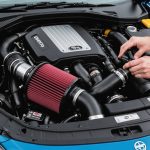Overview of Cold Air Intake Systems
A cold air intake system is a crucial modification for those seeking enhanced performance in British sports coupes. By rerouting the vehicle’s intake system to draw in cooler air from an unobstructed location, this component plays a significant role in improving engine efficiency. Cooler air is denser, meaning it contains more oxygen, which is essential for efficient fuel combustion. Consequently, this results in increased horsepower and torque, offering superior overall performance enhancement.
Installing a cold air intake in British sports coupes yields several benefits. Primarily, it boosts engine power, contributing to a more exhilarating driving experience. Additionally, it can improve fuel efficiency by enabling the engine to burn fuel more completely. This method not only supports energy conservation but also helps in reducing emissions. Therefore, these systems represent a vital upgrade for performance enthusiasts.
Also read : Mastering Dual-Zone Climate Control in Your British Luxury Sedan: A Guide to Ultimate Comfort
Several types of cold air intake systems are available, each catering to different vehicle models and performance needs. For instance, short ram intakes provide a compact design that fits seamlessly under the bonnet, while longer, more robust versions are tailored for maximizing airflow in broader engine spaces. Selecting the right type for one’s vehicle ensures optimal gains in performance and efficiency, catering to the needs of British sports coupe aficionados.
Tools and Materials Required
To ensure the successful installation of your cold air intake system, having the right installation tools and necessary materials is crucial. This comprehensive list will help you gather all you need before you begin.
Also to discover : Elevate Your British Sports Car”s Aerodynamics: A Guide to Perfecting Ride Height
First off, you’ll require basic tools such as socket wrenches, screwdrivers, and pliers. These are essential for loosening bolts and clamps around the air intake parts. Additionally, a ratchet set and a torque wrench will aid in securing the components with the correct tension, minimising the risk of damage.
Beyond the general tools, specific cold air intake parts are necessary. These typically include the intake tube, air filter, and mounting brackets. Ensure that you have all these components to fit the specifications of your vehicle model.
As for necessary materials, gasket sealant and hose clamps are vital. They ensure airtight seals and firm connections between the cold air intake parts, enhancing performance and longevity.
For sourcing these components, popular brands like K&N and AEM are highly recommended due to their reputation for quality and durability. Consider reaching out to local automotive suppliers or online stores for the best deals on these indispensable materials.
Step-by-Step Installation Guide
Installing a cold air intake system can significantly boost a vehicle’s performance, and following the correct steps ensures peak efficiency and safety.
Preparation and Safety Measures
Before starting the installation, conduct thorough pre-installation checks to ensure compatibility with your vehicle. Examine the cold air intake kit for all necessary components, and read through the provided instructions. Using correct performance parts is crucial to avoid mismatches.
Safety gear is essential. Wear safety glasses and gloves to protect against sharp edges and debris. Ensure the car is parked on a flat, stable surface, and disconnect the battery to prevent electrical hazards.
Removing the Existing Air Intake
Commence by safely removing the factory air intake. Carefully unclip any wires or sensors—avoid pulling them to prevent damage. Use the appropriate tools for loosening clamps and bolts. It’s advisable to take photos during the process, which can serve as a reference for reassembly.
Installing the New Cold Air Intake System
Begin fitting the new cold air intake by positioning the new tube and securing it with clamps. Connect any sensors or wires as previously noted during removal. Focus on aligning components correctly to prevent air leaks. Double-check all connections before reattaching the battery to ensure a smooth installation.
Troubleshooting and Common Issues
Navigating through installation challenges can be daunting, but a comprehensive Troubleshooting Guide can be immensely helpful. Installation Issues often stem from compatibility problems, such as mismatched system requirements or incorrect configuration settings. To resolve these, verify that your device meets all necessary specifications and closely follow the setup instructions to ensure proper integration.
Improper installation manifests in several telltale signs. These include unusual software glitches, unexpected error messages, or system slowdowns. Addressing these issues promptly is crucial as they can lead to broader Performance Problems if neglected. In some cases, reinstallation might be needed to rectify persistent errors.
Once installed, enhancing the system’s performance is key to achieving smooth operation. Start by adjusting configuration settings to match your usage preferences and requirements. Regular updates and software patches can also aid in maintaining optimal functionality. Additionally, ensuring that all drivers and related software are current can prevent potential performance hiccups.
Lastly, remember that consistent maintenance and monitoring can significantly reduce the frequency of troubleshooting needs. By keeping abreast of any updates or changes in the system, you can enjoy a seamless user experience without recurrent disruptions.
Performance Benefits and Visual Enhancements
Upgrading your vehicle with a cold air intake system can lead to noticeable performance gains. By enabling your car’s engine to access cooler, denser air, the system enhances engine efficiency. Consequently, this increases horsepower and torque, translating into improved acceleration and a more responsive driving experience.
One of the standout features post-upgrade is the potential improvement in engine sound. Many enthusiasts appreciate the deeper and more aggressive tone that often accompanies the installation of a cold air intake. This auditory enhancement complements the visual aspect of the system, as many models offer sleek designs that elevate the overall aesthetic of the engine bay.
Long-term, maintaining a cold air intake system contributes to sustained engine performance. Regular cleaning and ensuring the filter is in optimal condition can extend the system’s longevity and consistently provide performance benefits.
Moreover, a well-maintained system aids in reducing engine strain. This prolongs engine life, reducing the likelihood of mechanical issues. Overall, investing in visual upgrades and performance improvements through a cold air intake system is practical for both aesthetics and engine durability.
Maintenance and Longevity of Cold Air Intake Systems
Proper cold air intake maintenance is vital to ensure optimum performance and extend the system’s lifespan. Regular inspections and cleaning can prevent issues and maintain efficiency.
Start by examining the air filter, which can be clogged with dust and debris over time. It is essential to clean or replace the air filter as recommended by the manufacturer to enhance system longevity. A dirty filter restricts airflow, reducing engine efficiency.
Watch for signs indicating that maintenance is required. If you notice decreased acceleration or unusual engine sounds, it may be time for a check-up. Additionally, a significant drop in fuel efficiency could signal that your cold air intake needs attention.
Long-term care involves periodic inspections for cracks or loose connections in the intake pipes, which can lead to air leaks and diminish performance. Keeping the system clean not only ensures smooth operation but also optimises fuel economy.
By maintaining your cold air intake regularly, you not only preserve its performance but also benefit from improved engine power, increased fuel efficiency, and reduced emissions. Such maintenance habits foster long-lasting, high-functioning systems.
Conclusion and Recommended Resources
To ensure the best performance upgrades for your vehicle, consider diving into comprehensive additional resources and further reading. These materials can provide valuable insights and technical guidance to help you make informed decisions.
Engaging with online forums or communities can be an enriching experience. Platforms exist where car enthusiasts exchange detailed information and share firsthand experiences. Look for spaces such as enthusiast forums or social media groups that focus on specific car models or modifications. They often contain invaluable tips and help troubleshoot common issues related to performance upgrades.
Visual learners might benefit from videos or diagrams. Online video platforms often host an array of tutorials on upgrading components like exhaust systems, suspension kits, and turbo installations. These visual aids can demystify complex processes by offering step-by-step guidance through comprehensive illustrations.
For those seeking deeper knowledge, technical manuals or automotive engineering books are excellent resources. They can offer a more scientific understanding of performance dynamics and mechanical interaction.
A combination of these recommended resources will equip you with the necessary knowledge and skills. Whether you are a beginner or a seasoned car enthusiast, these materials cover a wide range of expertise levels to ensure you achieve desired performance enhancements.











